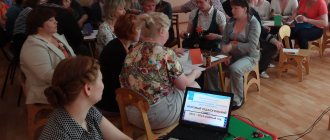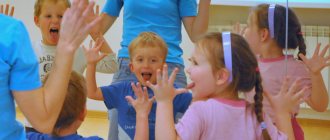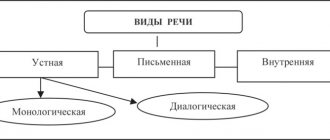MAGAZINE Preschooler.RF
“Finger gymnastics as a means of speech development for preschool children”Bolotova Natalya Viktorovna Teacher-speech therapist of the highest qualification category MBDOU "Kindergarten of compensatory type No. 17" Sergiev Posad municipal district Moscow region, Sergiev Posad,
annotation
This article examines the relevance and usefulness of finger games as a means of speech development during correctional and educational work in preschool institutions. The purpose, tasks of finger gymnastics, and the rules for its implementation are described. Examples of finger games for classes with children, “tied” to the study of lexical topics for the 1st period of study (September-November) are given.
Topic: “Finger gymnastics as a means of speech development for preschool children”
The popularity of finger games has increased significantly. Such games are not a newfangled hobby for modern parents. They have existed among different peoples since ancient times. And no wonder, because finger games are a wonderful way to cheer up a child, distract him from something, and find contact with any child.
The development of the motor side of speech depends not only on the functional capabilities of the facial-articulatory muscles directly involved in the implementation of speech acts; The development of a child’s speech is also indirectly related to the state of his general motor skills, i.e. motor activity in general.
Previously, it was believed that the main thing on which speech development depends is the degree of verbal communication between children and surrounding adults. However, research by scientists has shown that the degree of verbal communication with adults does not play as big a role as expected. They also studied the relationship between a child's speech ability and his motor functions. Studying the anatomical relationships of the child’s body, scientists, neuropathologists and defectologists came to the conclusion that the child’s speech ability depends not only on the training of the articular apparatus, but also on the movements of the fingers. The hand can be classified as a speech apparatus, and the motor projection area of the hand can be classified as
Finger gymnastics as a means of developing speech and fine motor skills
Chapter 1. Theoretical foundations of the use of finger gymnastics as a means of developing speech and fine motor skills of the hands of a child of primary preschool age
1. 1 From the history of the emergence of educational technology of finger games
The priority for recognizing finger games as official pedagogy belongs to German specialists. Back in 1873, the outstanding German teacher Friedrich Froebel highlighted the educational significance of finger games and included them in the curriculum of the kindergartens he created. Froebel suggested that it was the association of the sound and meaning of words with the child's own body that best suited the learning style of young children. At that time, there could be no theoretical justification for this method; Froebel made conclusions based on his own observations and intuition.
Previously, there were many folk finger games, nursery rhymes that accompanied the childhood of our great-grandmothers and grandmothers, games that are now forgotten or half-forgotten. Over the last decade, experts have been searching for and reviving such games, turning to ethnographers, folklorists, philologists for help, using specialized literature, and conducting surveys in various regions of Russia. Many of the newfound games are not outdated and are naturally perceived by children. The child encountered folk finger games already in the cradle, or rather, on the lap of his mother, grandmother, or nanny. These were not games yet, but nursery rhymes and nursery rhymes - fun between an adult and a child. Few people know that everyone’s favorite “Magpie-Crow”
doesn't end with the wiggling of the slacker little finger:
«You didn’t carry wood, you didn’t carry water.”
The game had a continuation.
The adult says: “Know in advance: The water here is cold”
(and stroked the child’s wrist).
“ It’s warm here”
(stroked it at the elbow);
“It’s hot in here”
(stroking it near the shoulder);
“And here it’s boiling water, boiling water!”
(tickled under the arm).
This fun game allows the child to feel the joy of physical contact, to feel his fingers, palm, elbow, shoulder; to realize oneself in the system of bodily coordinates, and ultimately to formulate a body diagram. This prevents the occurrence of many neuroses in the future and gives a person a sense of self-control. Similar games are found among many nations.
1.2The influence of finger games on a child’s development
Finger games develop a child's brain, stimulate speech development, creativity, and imagination. Simple movements help to remove tension not only from the hands themselves, but also to relax the muscles of the whole body. They can improve the pronunciation of many sounds. In general, the better the fingers and the entire hand work, the better the child speaks. Why is this so? Let's figure it out. The fact is that the hand has the largest “representation” in the cerebral cortex, therefore the development of the hand plays an important role in the formation of the brain and the formation of speech. And that is why the child’s verbal speech begins when the movements of his fingers achieve sufficient accuracy. The child’s hands, as it were, prepare the ground for the subsequent development of speech. In addition, the goal of classes to develop dexterity and accuracy of the fingers is to develop the relationship between the hemispheres of the brain and the synchronization of their work. In the right hemisphere of the brain we have various images of objects and phenomena, and in the left they are verbalized, that is, they find verbal expression, and this process occurs thanks to the “bridge” between the right and left hemispheres. The stronger this bridge, the faster and more often nerve impulses travel along it, the more active the thought processes, more precisely the attention, the higher the abilities. If you want your child to speak well, learn quickly and easily, and deftly perform even the most delicate work, start developing his hands: fingers and hands from an early age. Finger games have been common among a variety of peoples for a long time. In China, exercises with stone and metal balls are common. Regular exercises with them improve memory, activity of the cardiovascular and digestive systems, eliminate emotional stress, develop coordination of movements, strength and dexterity of the hands, and maintain vitality. And in Japan, exercises for palms and fingers with walnuts are widely used. Rolling a hexagonal pencil between your palms has an excellent effect. And from an early age we were taught to play “Ladushki”, “White-sided Magpie”, “Horned Goat”. Today, experts are reviving old games and inventing new ones. Finger games can be said to be an excellent universal, didactic and developmental material. The methodology and meaning of these games is that the nerve endings of the hands affect the child’s brain and brain activity is activated. For school learning, it is very important that the child has well-developed fine motor skills. Finger games are good helpers for preparing a child’s hand for writing and developing coordination. And in order for speech to develop at the same time, you can use small rhymes, counting rhymes, and songs for such games. In principle, teachers and parents themselves can “translate any poetic works of this kind onto their fingers,” i.e. come up with movements for the fingers that accompany speech - at first simple, uncomplicated, and then complicate these movements. Thanks to finger games, the child receives a variety of sensory impressions, he develops attentiveness and the ability to concentrate. Such games form good relationships between adults and children.
Development of speech in preschool children under the influence of finger games
Bibliographic description:
Development of speech in preschool children under the influence of finger games / O. E. Malygina, N. S. Glukhova, S. N. Yukhneva [etc.]. — Text: direct // Questions of preschool pedagogy. — 2022. — No. 3 (13). — P. 34-37. — URL: https://moluch.ru/th/1/archive/92/3217/ (access date: 01/18/2022).
The idea that during any motor training... it is not the hands that are being exercised, but the brain, at first seemed paradoxical and only with difficulty penetrated the consciousness of teachers.
N. A. Bershtein
The article is devoted to the issue of speech development of preschool children. The influence of finger gymnastics on the development of children's speech is revealed. The principles of using finger games in working with children are given.
Key words : speech development, finger gymnastics, fine motor skills, development of thinking.
People have long noticed that movements of the hands and fingers, accompanied by short poems, have a beneficial effect on the development of children's speech. Since childhood, the familiar “Magpie-Crow”, “This Finger...”, “Horned Goat” and other finger games are the most important means of children’s speech development. After analyzing the psychological and pedagogical literature, we found out that many teachers, psychologists, and speech therapists pay attention to the development of fine motor skills. Authors such as V.V. Tsvyntarny, O.A. Novitskaya, Yu.A. Sokolova describe individual techniques for the development of motor skills in children. A. A. Khvostovtsev, S. E. Bolshakova give more complete recommendations on the formation of motor skills and differentiated movements of the fingers in preschool children. [9]
M. M. Koltsova came to the conclusion that the formation of speech areas occurs under the influence of kinesthetic impulses from the hands, or more precisely from the fingers. [5, p.4]
It has been proven that both the thought and the child’s eye move at the same speed as the hand. This means that systematic exercises to train finger movements are a powerful means of increasing brain performance. The results of the study show that the level of speech development in children is always directly dependent on the degree of development of fine movements of the fingers. Fine motor skills are the basis of development, a kind of “locomotive” of all mental processes (attention, memory, thinking, perception, speech). [4, p.3]
According to employees of the Institute of Physiology of Children and Adolescents of the Academy of Pedagogical Sciences of the Russian Federation, when a child engages in finger gymnastics, the following happens:
- Performing exercises and rhythmic movements with the fingers leads to stimulation of the speech centers of the brain and increased activity of the speech zones, which stimulates the development of speech.
- Finger games teach you to listen and understand the meaning of speech, increasing children’s speech activity, and teach them to concentrate and distribute attention.
- Children's memory, imagination and fantasy develop.
- And as a result, the hands and fingers acquire strength and flexibility, which in turn makes it easier to master writing skills.
At what age can you start doing finger exercises? In Japan, finger exercises begin from the age of three months. Other experts advise training from 6–7 months. And even at a later age these activities will be effective.
Our team in its work with children on speech development is guided by the following principles:
- All exercises are performed slowly. You need to ensure that children perform finger exercises correctly and help if necessary.
- The exercises are practiced first with one hand, then with the other, and then with both hands (if the participation of both hands is not provided at once).
- Each exercise has its own drawing to create a visual sample. First, we show the children a color drawing and explain how this exercise should be performed correctly, then there is no need for explanations, we just show the picture and name the exercise, and the children reproduce it themselves.
When children know and complete all the exercises well, they can perform game tasks. For example: remember and repeat the movement according to verbal instructions or on a one-two count. You can also use your hands to tell a fairy tale or an interesting story to a child. For this task, we come up with fairy tales together with the children, then show them; the children really like to listen to such funny stories. This is how we came up with the fairy tales “Little Finger’s Journey”, “The Magic Handkerchief”, “Little Finger” and others. Children often repeat them in free activity, adding more and more details, developing the plot.
The pictures that we use in our work help us memorize exercises and develop children’s speech and imagination. In our group, we tried to select visual material for most finger games and developed schemes for memorization. Pictures for the games being studied are always within the children's access area.
We include all games and exercises in routine moments: while washing, in direct educational activities, when dressing and undressing children, while walking.
In the practice of our kindergarten we use the following types of finger games:
– Finger exercises combined with sound gymnastics.
The group has a developed card index of such exercises. They consist of simultaneous movement of the fingers and repetition of individual sounds and syllables: Pa-ta-pa, ba-bo-ba, and others.
– Manipulative games.
For these games we made elements from paper, thread, fabric, cardboard. They reflect simple subjects for children's manipulations: a hat, a skirt, a mushroom and others. With the help of such games, children enrich their sensory experience, develop coherent speech, imagination, and especially fine motor skills.
– Finger kinesiological exercises (“brain gymnastics”).
Proposed by I. Dennison and G. Dennison. With the help of such exercises, the work of the left hemisphere is compensated. Their implementation requires attention and concentration from the child. [eleven]
—
– Finger exercises combined with self-massage of the hands and fingers.
Children especially love to play with cereals, massage balls, nuts, hair ties, and buttons.
- Theater in hand.
Together with our parents, we made various types of theaters: walking, shadow, finger, on spoons, bi-ba-bo. Children learn to manipulate a doll, change the timbre and pitch of their voice, correlate movement with speech, and develop motor skills.
– Gymnastic finger games.
They involve performing certain movements to the lines of a poem. We selected poems and created a card index in accordance with the thematic planning of our kindergarten, for each topic there are one or two games, which we learn at the beginning of the week and repeat at various moments of the regime. So, within the framework of the “Dishes” theme, the guys perform finger gymnastics “Helpers”, the “Vegetables” theme - “Cabbage” gymnastics, etc.
- Tactile books.
As part of the enrichment of the developmental environment, we made folding books filled with fasteners, Velcro, lacing, made from various tactile materials, on a variety of subject topics: vegetable garden, hairdresser, house, furniture and others. Thanks to such games, children develop fine motor skills, form generalizing concepts, and develop coherent speech.
It is very important to interest and captivate parents with the topic of finger games. In our work, we used different forms of work: conversations, memos, consultations, parent meetings, at which we explained how important it is to perform finger exercises not only in kindergarten, but also at home, showed how to play with children at master classes, and replenished our pedagogical knowledge parents with new poems. After some time, parents began to notice that their children’s speech became clearer, coordination of movements and fine motor skills improved. In addition, having learned a large number of finger games in verse with their children, it became easier for parents to occupy their child on the road, while waiting in line for a long time, and to cheer up.
Conclusions:
We want to sum it up with the words of the famous teacher V.A. Sukhomlinsky: “The child’s mind is at the tips of his fingers.” Finger games and exercises are a unique means of developing fine motor skills of hands and speech, spatial and visual thinking, auditory and visual perception, voluntary and involuntary thinking; they expand children’s vocabulary, horizons, and create a positive emotional state. In addition, playing with fingers helps to establish close contact with the child and maintain an emotional connection. When a mother takes the baby in her arms for finger play, sits him on her lap, hugs him, holds him, when she touches his palm, strokes or tickles, pats or rocks, the child receives a lot of impressions necessary for his emotional and intellectual development. [7, p.2] Finger games are very popular with preschool children and allow them to solve many problems: from educational to recreational.
Literature:
- Kosinova E. M. Speech therapist lessons: games for speech development / Elena Kosinova. - M.: Eksmo: OLISS, 2011.
- Agapova I. A., Davydova M. A. “Finger games for the development of speech and creative abilities of children.” - M.: LLC "IKTC LADA", 2011;
- Anishchenkova E. S. “Finger gymnastics for the development of speech in preschool children.” - AST, 2013.
- Anishchenkova E. S. “Speech gymnastics for the development of speech in preschool children.” — Profizdat, 2011.
- Boguslavskaya Z. M., Smirnova E. O. “Educational games for preschool children.” - M.: Education, 2012.
- Borisenko M. G., Lukina N. A. “Our fingers are playing.” - St. Petersburg: “Parity”,
- Gromova O. N., Prokopenko T. A. “Fun games for the development of fine motor skills in children.” - M.: “GNOM and D”, 2012;
- Savina L. P. “Finger gymnastics for the development of speech of preschool children”: - M.: LLC “AST Publishing House”, 2011.
- Uzorova O. V. “Finger games.” - M. "AST Publishing House", 2014.
- The role of finger games in the development of speech and fine motor skills of children. Alekseeva E. V. - https://nsportal.ru/detskiy-sad/logopediya/2013/02/16/rol-palchikovykh-igr-v-razvitii-rechi-i-melkoy-motoriki-detey (02/17/18)
- Methodological material on the topic: “Finger games”, Uskova V. A. https://infourok.ru/metodicheskiy-material-na-temu-palchikovie-igri-966364.html
Key terms
(generated automatically)
: child, game, finger gymnastics, exercise, fine motor skills, kindergarten, preschool age, hand, speech development, coherent speech.
Finger games for speech development
The essence of the finger motor skills lesson is to teach the child to use his fingers to depict some objects or living beings. In this case, all finger movements must be explained to the baby. This will help the child understand concepts such as “top”, “bottom”, “right”, “left”, etc. After the child learns how to do the exercises himself, you can try to act out scenes or short fairy tales, distributing the roles among yourself and your little actor (for example, a meeting between a hedgehog and a bunny in the forest). Here are some examples of such exercises.
- Finger game\
- . The index and middle fingers are straightened, the rest are clenched into a fist. Little man. “Run” with your index and middle fingers on the table.
- Finger game\
- . Clasp your hands, straighten the fingers of one hand and the thumb of the other. Cat. Connect the middle and ring fingers with the thumb, raise the index and little fingers up. Horned goat. The index and little fingers are straight, the thumb is on the bent ring and middle fingers. Butterfly. Cross your hands at the wrists and press your palms with the backs of your hands facing each other, fingers straight; palms with straight fingers make slight movements in the wrists - “butterfly flies.” Glasses. Fold the fingers of your right and left hands into rings and bring them to your eyes.
In addition to these examples, you yourself can come up with many interesting and entertaining exercises for your child to develop speech.





